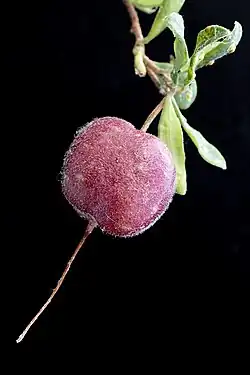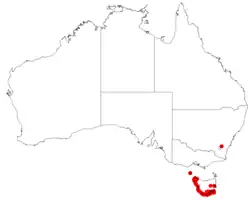Billardiera ovalis
| Billardiera ovalis | |
|---|---|

| |
| In the Australian National Botanic Gardens | |
| Scientific classification | |
| Kingdom: | Plantae |
| Clade: | Tracheophytes |
| Clade: | Angiosperms |
| Clade: | Eudicots |
| Clade: | Asterids |
| Order: | Apiales |
| Family: | Pittosporaceae |
| Genus: | Billardiera |
| Species: | B. ovalis
|
| Binomial name | |
| Billardiera ovalis | |

| |
| Occurrence data from Australasian Virtual Herbarium | |
| Synonyms[1] | |
|
Billardiera longiflora var. ovalis (Lindl.) E.M.Benn. | |
Billardiera ovalis is a species of flowering plant in the family Pittosporaceae and is endemic to Tasmania. It is a woody, creeping scrambler with thick, egg-shaped or elliptic leaves, and creamy-yellow flowers arranged singly in leaf axils, but turning red as they age.
Description
Billardiera ovalis is a woody, creeping scrambler with shaggy-hairy new shoots. Its leaves are clustered on short side-shoots and are spatula-shaped at first, later egg-shaped with the narrower end towards the base, or elliptic, 16–24 mm (0.63–0.94 in) long, about 5 mm (0.20 in) wide and more or less sessile. The leaves are thick, both surfaces pale green and waxy, streaked with purplish-red on the lower surface. The flowers are arranged singly on hairy peduncles 8–9 mm (0.31–0.35 in) long. The sepals are broadly egg-shaped, reddish-purple and overlap each other, 2.0–2.5 mm (0.079–0.098 in) long and about 1.5 mm (0.059 in) wide. The petals are creamy-yellow, turning wine red as they age, and less than 20 mm (0.79 in) long. Flowering occurs in summer and the mature fruit is usually a bright red, egg-shaped berry about 10 mm (0.39 in) long.[2][3]
Taxonomy
Billardiera ovalis was first formally described in 1834 by John Lindley in Edwards's Botanical Register.[4][5] The specific epithet (ovalis) means "oval" or "elliptic".[6]
Distribution and habitat
This species of billardiera grows in scrub on coastal dolerite from King Island to south-eastern Tasmania.[2][3]
References
- ^ a b "Billardiera ovalis". Australian Plant Census. Retrieved 19 June 2023.
- ^ a b "Billardiera nesophila". Australian Biological Resources Study, Department of Agriculture, Water and the Environment: Canberra. Retrieved 17 June 2023.
- ^ a b Jordan, Greg. "Billardiera ovalis". University of Tasmania. Retrieved 19 June 2023.
- ^ "Billardiera ovalis". APNI. Retrieved 19 June 2023.
- ^ Lindley, John (1835). "Billardiera ovalis". Edwards's Botanical Register. 20: 1719. Retrieved 19 June 2023.
- ^ William T. Stearn (1992). Botanical Latin. History, grammar, syntax, terminology and vocabulary (4th ed.). Portland, Oregon: Timber Press. p. 459.
- ^ Lindley, John (1835). "Billardiera ovalis". Edwards's Botanical Register. 20: 1719. Retrieved 19 June 2023.
_(21172828955).jpg)